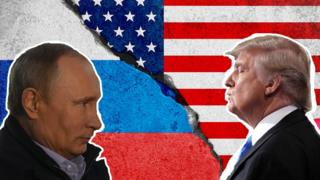What was the Cold War?
It was a dramatic show of solidarity that has escalated long-standing tensions between Russia and the West.
On Monday, the US and its allies expelled dozens of Russian diplomats in response to the poisoning of a former Russian spy in the UK.
It was the biggest such expulsion since the height of the Cold War era and the hostilities with the then Soviet Union.
There are now fears of a serious diplomatic crisis and a freezing in relations between Moscow and the West which has raised the spectre of the Cold War once again.
What was the Cold War?
This term describes the tense relationship between the US and the Soviet Union from 1945 to 1989.
Neither side ever fought the other directly because the fear of nuclear war, which gripped millions of people at the time, was too terrifying to contemplate.
Instead, historians consider it to be a war between two opposing systems of government. The US and the West represented capitalism and the Soviet Union represented communism.
Both sides had very different ideas of how to run a country and both believed their system was superior. A source of major tension was that they both believed the other side was trying to spread their belief system around the world.
How did it begin?
There is no single answer to this, but historians generally point to the end of World War Two in 1945 as a key turning point.
This is because during the war the US and Soviet Union had been allies, but the relationship was forged in the face of a common enemy in Nazi Germany and did not last.
The war left Europe divided and the two sides emerged as the world’s most dominant superpowers.
Given their opposing belief systems, there were disagreements about how the post-war world should be ordered and how Europe should be divided up.
This sparked a fierce rivalry and a freezing in relations as both powers competed for dominance.
So what happened?
The two sides organised into major alliances. The US and the West formed NATO, and the Soviet Union formed the Warsaw Pact with eastern European countries such as Poland and Hungary.
Crucially, both sides feared the other and so they began to rapidly build and stockpile weapons.
By the 1960s, the US and the Soviet Union could deliver nuclear missiles across continents at high speeds. By the end of the decade both sides had developed anti-ballistic missile systems to defend themselves.
Nuclear war was narrowly averted following the Cuban Missile Crisis in 1962.
Proxy wars, whereby the US and Soviet Union supported a side without participating directly, were commonplace.
“The Cold War was never really that cold,” says Malcolm Craig, a senior lecturer in US history at Liverpool John Moores University.
“Millions of people died in proxy conflicts or in conflicts that the superpower struggle imposed itself on without any recognition of the conflict’s fundamental local nature. For Cambodians, Congolese, Koreans, Ethiopians, Somalians, and many, many others, the Cold War was very much a hot war.”
How do current tensions compare?
There are certainly echoes of the Cold War in the recent expulsions of Russian diplomats.
In 1986 for example, the US and the Soviet Union exchanged tit-for-tat expulsions over a period of several weeks. US President Ronald Reagan expelled 80 Russian diplomats, five of whom were suspected of spying.
There have also been comparisons made between the poisoning of a former Russian spy and Soviet behaviour during the Cold War.
“The Soviet Union clearly did try and kill people abroad who they didn’t like,” says Michael Cox, Emeritus Professor of International Relations at the London School of Economics. “So it isn’t that Russia is doing anything novel in that regard.”
But the history of this kind of behaviour from Russia goes back further than the Cold War.
“The tactics that are making the news, such as assassinations, have a much deeper history than the Cold War era,” says Malcolm Craig. “The sense that we face a new Cold War because of such tactics is slightly false.”
So how worried should we be? “We still have nuclear weapons and these are still a major deterrent. There are important economic relations between Russia and the EU which are not insignificant. There are also many Russians who live in the West,” says Michael Cox.
There are also fundamental differences between the Soviet Union and modern-day Russia that make the current tensions less worrying.
“Russia is not the Soviet Union, and its international position is quite, quite different,” says Malcolm Craig. “It is much more tightly integrated into the global economic system than the USSR was, making it more susceptible to economic pressure.”
“I can’t imagine that Putin would want a long-term freezing of relations and more and more sanctions,” adds Michael Cox.
But he warns that the present tensions are unpredictable.
“The one thing the Cold War managed to do, at least until 1989, was keep the two sides quite far apart from one another. There was a kind of spheres of influence acceptance,” he says.
“The demarcation zones seem to have broken down completely.”
Source: Read Full Article



